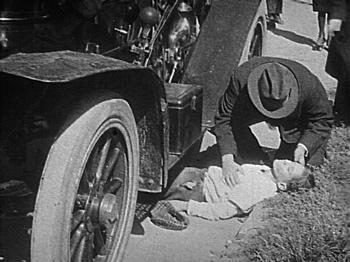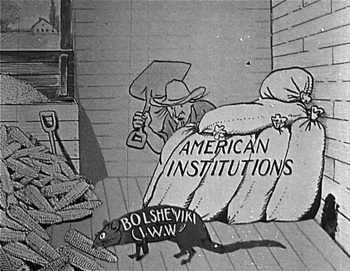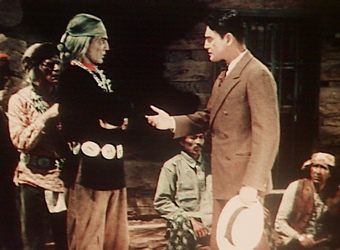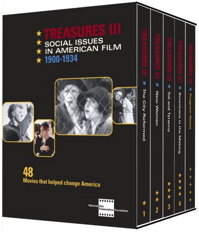The films were gathered from a number of American archives and organized in the same way as the previous release of the National Film Preservation Foundation, Treasures from American Film Archives of seven years ago. Four discs carry over twelve hours of films, each accompanied by a new music score and a commentary by an expert sociologist or film historian. In addition to many short subjects, instructional and propaganda films, the collection includes several full-length features (one in 2-color Technicolor). Directors include Cecil B. De Mille, William Desmond Taylor, King Vidor, Lois Weber; stars include Richard Dix and Mary Pickford.
Disc 1: The City Reformed
The Black Hand 1906, 6 min.
Perhaps the very first 'Mafia' film. Thugs extort money from an honest Italian butcher, but two policemen hide in his freezer to catch them. Like many of these early 'expose' stories, this was based on an incident that happened only a few days before filming.
How They Rob Men in Chicago 1900, 25 seconds
A cynical bit of social comment: A thief uses a woman to distract his mark. When the victim is helpless on the floor, a policeman just takes his money!
The Voice of the Violin 1909, 16 min.
D.W. Griffith
Godless terrorists -- Marxist, anarchists, and other good-for-nothings -- enlist an unhappy musician to help bomb the house of a 'monopolist'. Since these groups actually existed, this is a fascinating record of their image in the media of the time.
The Usurer's Grip 1912, 15 min.
An interesting drama about a common problem: we're told that 35% of NYC workers owed money to illegal lenders, and were doubly helpless because exposure usually resulted in being fired from one's job.
From the Submerged 1912, 11 min.
Theodore Wharton
A fully realized socially conscious story. A penniless bum comes into an inheritance and finds out that his new society swells have a bad attitude to poverty ... they go on a 'slumming party' to observe the amusing folks on skid row.
Hope - A Red Cross Seal Story 1912, 14 min.
An early example of a film designed to raise awareness for a specific problem, in this case tuberculosis. A doctor scoffs at the idea that TB, a 'city problem' could rear its head in a country setting.
 The Cost of Carelessness 1913, 13 min.
The Cost of Carelessness 1913, 13 min.
Underwritten by a streetcar company, this early traffic safety film shows people how to get on and off streetcars without being crushed or shredded by traffic. Some fairly convincing mayhem on Main Street. To demonstrate a streetcar fitted with a special catcher shield, the filmmakers actually partially run over a small boy.
Lights and Shadows in a City of a Million 1920, 7 min.
A Ford Motor Company film promoting public charity for a community fund.
6 Million American Children Are Not in School 1922, 2 min.
Lewis Selznick produced this public-service film protesting against child labor. Kids haul fabric in New York and six year-olds process shrimp in Biloxi. The notes for this one show that the filmmakers exaggerated some of the facts, although the child labor situation in 1922 was still nothing to brag about.
The Soul of Youth 1920, 80 min.
William Desmond Taylor
Hollywood's most famous murdered director made this story of the Juvenile Court system championed by one Judge Lindsey. Several case stories are dramatized, stressing a sympathetic approach and family adoption over dank orphanages.
A Call for Help from Sing Sing! 1934, 3 min.
This is an expanded newsreel segment (with sound) in which an outspoken prison warden calls for reforms to keep young offenders out of prison. It acknowledges the fact that thousands of boys and young men abandoned by the Depression are out looking for work, and are bound to get into trouble.
Disc 2: New Women
Kansas Saloon Smashers 1901, 1 min.
Edwin S. Porter
An amusing one shot-one angle film of 'Carrie Nation' and her Temperance women destroying a bar; a special effect shows a mirror breaking without harming the mirror. Kansas saloons had been outlawed for years, so the sheriff arrested her for disturbing the peace. "You can't be charged with destroying that which does not exist!"
Why Mr. Nation Wants a Divorce 1901, 2 min.
Edwin S. Porter
A typical reactionary joke film. While Carrie is out terrorizing saloons, her husband tries to cope with the kids and a baby. A sign on the wall says, "What is a home without a MOTHER?"
Trial Marriages 1907, 12 min.
Francis Marion
Another backlash film reacting to the notion blind marriage agreements might not be the best idea for society. Each of the comic vignettes takes the man's point of view; each of his 'trial unions' is a total disaster. A progressive idea held up to ridicule.
Manhattan Trade School for Girls 1911, 16 min.
Girls between 14 and 17 attend this 'useful trade' academy, stressing that most working class kids didn't even go to high school before the 1920s. It's sort of a finishing school for the underprivileged.
The Strong Arm Squad of the Future 1912, 1 min.
A weird, prejudiced cartoon that pictures suffragettes as psychos, masculine brutes and neurotics.
A Lively Affair 1912, 7 min.
A more elaborate slam at suffragettes shows the women as irresponsible, yammering ninnies. One steals a little girl's bicycle (typical suffragette behavior!) and they argue during a card game. The cops have to come break up their meeting before it turns into a riot, and they all land in the hoosegow. This must have helped form a lot of negative opinions.
A Suffragette in Spite of Himself 1912, 8 min.
Bannister Merwin
Made in England by the Edison Company, this shows a man victimized when some kids tack a pro- women's rights sign on his back. Once again, chaos, but the hysterics this time are all male.
On to Washington 1913, 80 seconds
A newsreel fragment showing New Jersey suffragettes beginning a march to Washington. Compare the 'costumes' with the Temperance Parade in The Wild Bunch, which is supposed to take place in the same year.
The Hazards of Helen, Episode 13 1915, 13 min.
Paul C. Hurst
Spirited Helen Holmes is the star of this action serial. A railroad telegraph operator loses her job after her office is robbed, but she goes after the thieves as if she were Indiana Jones, and gets her old job back again. Very exciting action in and around trains; and surely a liberating fantasy for young girls.
Where Are My Children? 1916, 65 min.
Lois Weber
One of the best films here, this feature is for birth control but against abortion. A group of rich housewives secretly have abortions so as not to interrupt their leisurely lifestyle; while one husband yearns to have children. Then comes an abortion-related death, a trial, and a revelation that brings on the demand of the title. With a creepy, The Blue BIrd- like depiction of heaven populated with children waiting to be born -- and abandonded to limbo when their mothers destroy them.
The Courage of the Commonplace 1913, 13 min.
A Vitagraph film with a well thought out message. A hardworking girl on a farm sacrifices everything to help out, including her chance to escape to a better life at college. Very much like George Bailey in It's a Wonderful Life, Mary Charleson lets her 'pretty' sister have the easy road with beaus and dates while she takes care of baby brothers and gives up her school money to help buy a new horse.
 Poor Mrs. Jones! 1926, 46 min.
Poor Mrs. Jones! 1926, 46 min.
Produced by the U.S. Department of Agriculture, this is practically work of art. Frazzled farm wife Leona Roberts takes a needed vacation to visit 'rich' relatives in the city, only to find that conditions in the city leave a lot to be desired. Beautifully made on all counts.
Offers Herself as a Bride for $10,000 1931, 2 min.
A great little time capsule: a quickie interview with a woman who became a media sideshow by advertising herself as willing to marry for money to help support her parents. One expects a scam artist but the woman placing the ad is obviously sincere. The disc set notes tell her entire story, outside the brief film newsreel.
Disc 3: Toil and Tyranny
 Uncle Sam and the Bolsheviki I.W.W. Rat 1919, 40 seconds
Uncle Sam and the Bolsheviki I.W.W. Rat 1919, 40 seconds
The collection moves into pure propaganda with an anti-Union cartoon propagated by The Ford Motor Company, which presents all labor organizers as literal vermin to be exterminated. Pretty ugly stuff. Curiously, the assassin-farmer does his dirty work while Hiding Behind the 'American Institutions'.
The Crime of Carelessness 1912, 14 min.
A manufacturer's association produced this effective piece about a thoughtless worker whose smoking burns down a factory. Interestingly, the argument isn't totally one-sided; the owner is accused of blocking fire exits as well. It ends with a labor-management reconciliation almost identical to Metropolis, made fifteen years later.
Who Pays? Episode 12 1915, 35 min.
Future director Henry King co-wrote and stars in this final chapter of a serial about labor strife in a northwestern lumber yard. A brutal foreman starts a fight that results in the firing of an employee, whose wife dies from worry. In retaliation, the employee steals a Union organizer's gun (?) and tries to assassinate the heartless mill owner. A prime forerunner of the "It's everyone's problem" school of social consciousness; blame is not assigned to one side of the issue.
Labor's Reward 1925, 13 min.
One reel survives of an originally longer serial produced by the AFL. The importance of working and buying Union label only is driven home with some fairly weak melodramatics. This sums up the uninspired good intentions of much pro-Union propaganda.
Listen to Some Words of Wisdom 1930, 2 min.
A talkie newsreel conversation between 'Mr. Courage' and 'Mr. Fear' is a rather silly attempt to convince people to keep spending after the Stock Market crash, to make America strong again. That's a mistake! The best advice for early 1930 is to get your money out of uninsured bank accounts!
 The Godless Girl 1928, 128 min.
The Godless Girl 1928, 128 min.
Cecil B. DeMille
The most prestigious feature in the set is this typically brilliant, but politically insane show about an absurd conflict between rabid Christians and provocative atheists. It's De Mille's last silent picture and stars Marie Prevost and James Duryea (who, if the IMDB is correct, as Tom Keene, would later star in Plan 9 from Outer Space). Scandal-crazy atheist kids disrupt a high school and a counter-riot by Bible-thumper teens results in the death of a young girl. Three are sent to a reform institution, including the leader of the Christian zealots (yeah, sure), and the picture suddenly switches to a kids-in-sadistic-prison epic. The ending message is supposed to be about tolerance, but in the movie I see, the atheist changes her stripes. With a stunning riot scene and one of the better fire scenes in early film history.
Disc 4: Americans in the Making
Emigrants Landing at Ellis Island 1903, 2 min.
Raw newsreel footage of foreigners alighting on American soil.
An American in the Making 1913, 15 min.
U.S. Steel made this picture about the great opportunities for immigrants in the steel industry, killing several birds with one film by including bits about the Steel works' safety programs and socially progressive schools, etc., for children of the workers. It's a terrific look at how 'good' immigrants are pictured; our Czech hero forgets all about the Old Country, finds himself a nice American schoolteacher and starts with a clean slate.
Ramona 1910, 16 min.
D.W. Griffith
Griffith's classic reduces the famous story to a handful of vignettes, but is an impassioned plea for Indian rights. Stars Mary Pickford and Henry B. Walthall.
 Redskin 1929, 82 min.
Redskin 1929, 82 min.
Victor Schertzinger
A deluxe Paramount picture filmed in 2-strip Technicolor, except for scenes in the White Man's world, which are in tinted B&W. Canyon de Chelly and a Pueblo rock community provide scenery for a pretty good story of a Navajo (Richard Dix) who rejects White society while at college and returns to his tribe. They reject his modern ways as well, so he decides to steal his beloved from the enemy Pueblo tribe before she can be forced to marry a brave she doesn't love (Noble Johnson). Reasonably well told and exciting; the message is folded into a conventional narrative.
The United Snakes of America 1917, 80 seconds
Another feeble political cartoon short by the increasingly right-wing Ford Motor Company. Giant serpents representing evil German sympathizers, the congress and 'propagandists' hinder Uncle Sam from fighting the Hun.
 100% American 1918, 14 min.
100% American 1918, 14 min.
Arthur Rosson
Mary Pickford animates this cute short about a petty girl that hears a patriotic speech and changes her ways. She saves for war bonds instead of squandering her money like her frivolous girlfriend. Her end reward is the return of her war hero and a big party!
Bud's Recruit 1918, 26 min.
King Vidor
A great little picture about a foppish fellow who doesn't want to go to war. His gung-ho younger brother volunteers in his name, forcing him to act like it was his idea all along. When he leaves at the end, the movie communicates hints that it might be a big mistake. This is said to be King Vidor's earliest surviving film, and it's quite sophisticated in effect.
The Reawakening 1919, 10 min
The Ford Motor Company sponsored this cheery picture about maimed veterans being made 'good as new' by veterans' hospitals, given artificial limbs, etc. Its heart may be in the right place, but the film studiously avoids the thousands of men left with terrible disfigurements, or restricted to bed for the rest of their lives because of lung damage from gassing.
Eight Prohibition Newsreels 1923 - 1933, 13 min.
The collection ends on a light note with a set of shorts depicting the changing attitude toward Prohibition. Halfway through, even the filmmakers seem to regret seeing the cases of booze being smashed. Sound newsreels at the end have famous politicians like Al Smith and Fiorello La Guardia expressing contempt at an official finding declaring that prohibition must be maintained. Unfortunately, Prohibition was one of the main offshoots of the suffrage movement!








 The Cost of Carelessness 1913, 13 min.
The Cost of Carelessness 1913, 13 min.  Poor Mrs. Jones! 1926, 46 min.
Poor Mrs. Jones! 1926, 46 min.  Uncle Sam and the Bolsheviki I.W.W. Rat 1919, 40 seconds
Uncle Sam and the Bolsheviki I.W.W. Rat 1919, 40 seconds The Godless Girl 1928, 128 min.
The Godless Girl 1928, 128 min.  Redskin 1929, 82 min.
Redskin 1929, 82 min.  100% American 1918, 14 min.
100% American 1918, 14 min.